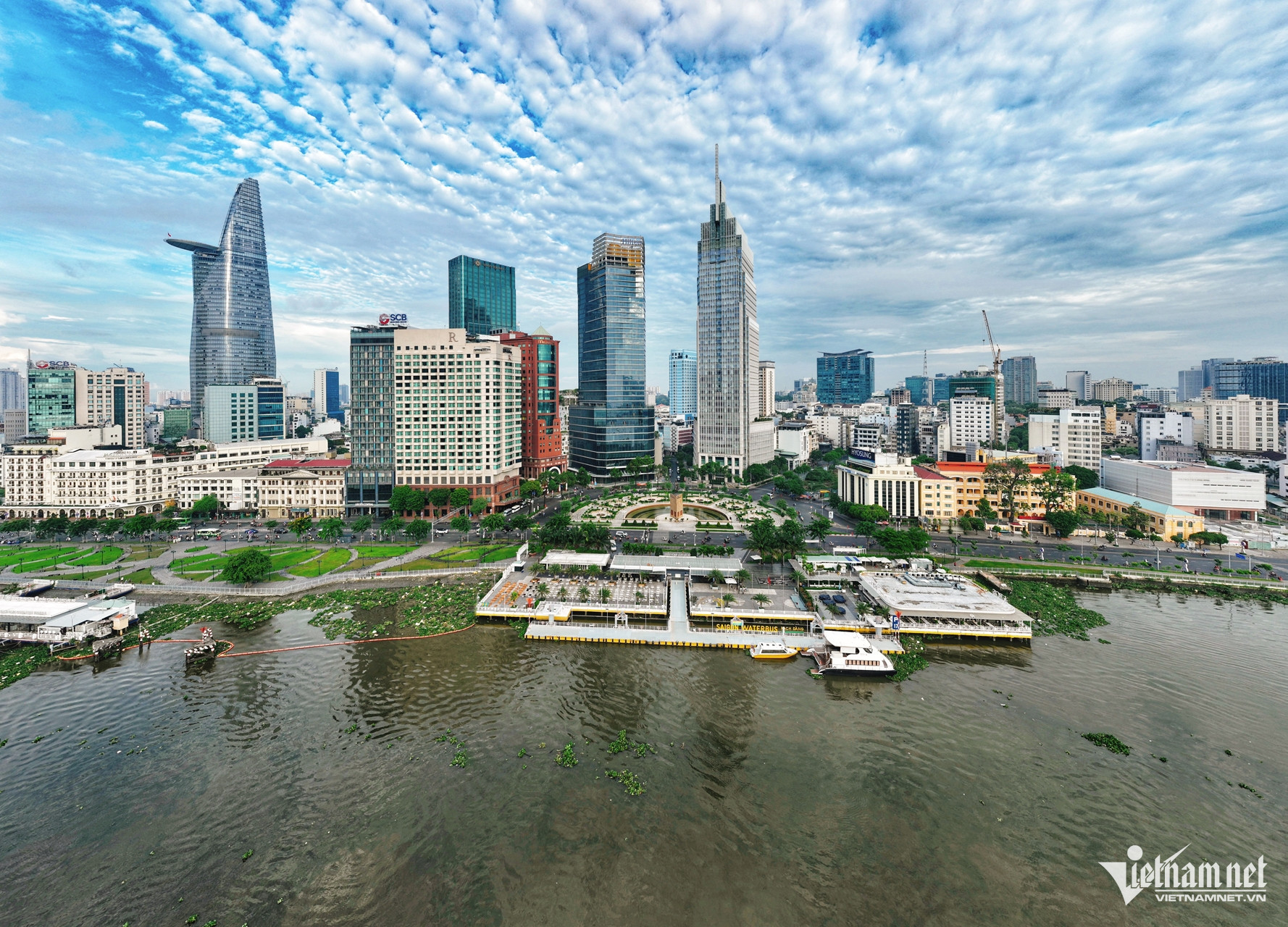Fifty years after national reunification, Ho Chi Minh City has transformed into the most dynamic economic hub in Vietnam. Innovation now permeates every aspect of urban life - from infrastructure and technology to how people live, work, and connect with the world.
However, rapid development brings with it complex challenges: population pressure, overloaded infrastructure, climate change, and development disparities between the urban core and outlying areas.
As the Party and State are implementing major policy initiatives to propel the country forward, Ho Chi Minh City - Vietnam’s economic locomotive - must also tackle its own challenges with long-term, practical, and comprehensive strategies.
VietNamNet introduces the series "Ho Chi Minh City: Removing bottlenecks to rise into the future," featuring strategic proposals from veteran experts working across developed countries. With a global perspective and a deep emotional connection to the city, these experts share a common aspiration: for Ho Chi Minh City to become a smart, livable, nature-friendly urban center with a unique identity amid globalization.

Dr. Huynh Dat Vu Khoa, born in 1977 and raised in Ho Chi Minh City during the post-war years, recalls childhood memories of cool rivers, boat racing festivals, and bowls of barley rice...
After graduating university, he moved to Europe for study and work. With each return, he was amazed by the city’s transformation - but also by the "wounds" of rapid urbanization that now need healing.
“In every future plan, the environment must come first. Sustainable development should guide all of Ho Chi Minh City's growth,” Dr. Khoa emphasized.
“If we achieve this, Ho Chi Minh City will not only remain the heart of Vietnam’s economy, but also become a green, peaceful place where people come not just for jobs, but for connection, serenity, and pride.”
“I hope the city, now and in the years ahead, becomes a symbol of both material prosperity and spiritual fulfillment.”
Three strategic pillars

As a senior advisor at the Norwegian Geotechnical Institute and Director of the Energy and Marine Network at AVSE Global, Dr. Khoa and his colleagues outline three strategic pillars for Ho Chi Minh City: digital economy, sustainable development, and high-quality human resources.
To meet the ambitious goal of having the digital economy account for 45% of the city’s GDP by 2030, Dr. Khoa argues that IT infrastructure must be the top investment priority to support Industry 4.0 sectors.
The city must also accelerate the development of innovation hubs - models successfully implemented in Singapore and Taiwan - to attract startups, nurture tech ideas, and drive cutting-edge industries like semiconductors.
A standout example is the $2 billion Thu Thiem Eco Smart City project, backed by a South Korean conglomerate, which aims to develop a smart urban area with advanced IT infrastructure and integrated financial, commercial, and entertainment services.
Digital technology will also help Ho Chi Minh City manage urban systems more efficiently, from smart traffic to administrative reform, improving residents’ quality of life.
According to Dr. Khoa, sustainable development is vital to the planning and growth of any city. With its unique geography, Ho Chi Minh City is especially vulnerable to climate change, flooding, and sea-level rise.
The city must urgently implement adaptive strategies, prioritizing renewable energy - especially solar power. Urban planning should integrate green spaces, corridors, and open parks. Modern public transportation systems, particularly metro and electric buses, are essential to reducing emissions and improving the urban environment.
Dr. Khoa also highlighted the long-standing problem of the city’s drainage system.
“It was built during the French colonial era for 500,000 people. Today, the population nears 10 million. Upgrading it is essential to address flooding and adapt to climate change.”
He stressed that all major infrastructure - including highways, seaports, and interprovincial rail - should be designed with climate resilience in mind, using sustainable materials and eco-friendly technologies.
The third strategic pillar is human resources. Dr. Khoa believes that this is the cornerstone of all development. He recommends strong investment in training high-quality workers for both the short and long term, especially in high-tech sectors.
He proposed expanding partnerships with international educational institutions and research centers - a model proven effective across Europe. Cross-disciplinary and transnational programs can help create a globally competitive workforce.
Streamlining administration and digitizing government

As administrative reforms accelerate nationwide, Ho Chi Minh City is expected to take the lead in streamlining its bureaucracy, modernizing governance, and redefining its development model as a major metropolitan hub in the region.
Dr. Dinh Thanh Huong, Executive Director of Knowledge and Projects at AVSE Global, shared that since 2023, the organization has advised the city on an administrative reform agenda encompassing streamlining, operational efficiency, and full digital transformation.
“Ho Chi Minh City’s private sector is very dynamic, but the administrative apparatus hasn’t kept up. Streamlining is a prerequisite for efficient governance and responsive development,” Dr. Huong noted.
AVSE previously recommended eliminating redundant administrative procedures by reviewing workflows across departments. Simplifying these processes can shorten handling times and improve services for citizens and businesses.
This should go hand in hand with digitizing all documents and procedures - a long-standing goal that remains slow in implementation.
“It’s still common for officials to use personal emails for important government documents. This is not only unprofessional but also a security risk,” AVSE experts warned.
They called for a shared, city-wide database that connects all government agencies, ensuring transparency and consistency in decision-making. This would also lay the groundwork for deploying technologies like AI and big data in smart city governance.
Administrative mergers: A bold but necessary move

Alongside administrative reform, AVSE sees the consolidation of provinces and administrative restructuring as both bold and urgent.
From a professional perspective, Dr. Huong said, “There are provinces with populations just over 600,000, like Quang Tri, while districts like Binh Chanh in Ho Chi Minh City have nearly 1 million residents. This creates inefficiencies in resource allocation and governance.”
Merging provinces can reduce administrative overhead and ease the strain on the national budget. Instead of maintaining three separate provincial governments and their agencies, a merged entity would need only one, streamlining policy implementation and improving efficiency.
“For example, instead of 63 Departments of Science and Technology, we’d only need 34. This would make innovation and digital transformation policies easier to coordinate and enforce,” Dr. Huong explained.
She expressed optimism that many of AVSE’s past proposals are gradually being realized, including flexible financial mechanisms to support the downsizing process - such as early retirement packages.
Rather than holding unmotivated positions, capable individuals could use these packages to launch startups, invest in local products, or support their children’s ventures.
“This would create new momentum between the public and private sectors, driving innovation and local economic growth,” she said.
AVSE also supports expanding Ho Chi Minh City’s administrative boundaries and connecting with nearby localities to form a large metropolitan region with a comprehensive economic, industrial, innovation, and logistics ecosystem.
According to Dr. Huong, these neighboring areas already have strengths: Binh Duong is a major industrial hub, and Ba Ria - Vung Tau excels in international ports and tourism. When linked, Ho Chi Minh City could form an ecosystem capable of competing with leading global city models.
However, the city must restructure administrative levels, reallocate resources, and clearly define the roles of each locality. This requires long-term vision, consensus from central government and neighboring provinces, and a well-structured implementation roadmap.
About AVSE Global
Founded in France in 2011, AVSE Global is a non-profit international organization that connects Vietnamese intellectuals worldwide. By 2019, it had brought together over 10,000 senior professionals and scientists across multiple disciplines.
AVSE Global’s mission is to channel global Vietnamese expertise into Vietnam’s sustainable development through policy consulting, knowledge transfer, and technology innovation.
It runs strategic programs in economics, education, technology, smart cities, and innovation, and regularly partners with government bodies, universities, and businesses to organize international forums and capacity-building projects.
With a presence in over 20 countries, AVSE Global plays a vital role in linking global Vietnamese intellect with national development goals, helping elevate Vietnam’s position in the global landscape.
Nguyen Thao